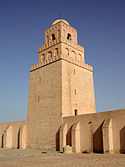Ibn Abi Zayd al-Qayrawani
Ibn Abī Zayd | |
|---|---|
| Personal | |
| Born | 922 |
| Died | 386/996[1] |
| Religion | Islam |
| Denomination | Sunni |
| Jurisprudence | Mālikī[1] |
| Creed | Ash'ari[2][3][4][5] |
| Main interest(s) | Aqidah, Fiqh |
| Notable work(s) | Al-Risalah al-Fiqhiyyah |
| Muslim leader | |
Influenced by | |
Influenced | |
Ibn Abī Zayd (Arabic: ابن أبي زيد القيرواني) (922–996), fully Abū Muḥammad ʿAbd Allāh ibn Abī Zayd ʿAbd al-Raḥmān al-Nafzawī ibn Abī Zayd al-Qayrawanī,[7] was a Maliki scholar from Kairouan in Tunisia and was also an active proponent of Ash'ari thought.[1][2][8] His best known work is Al-Risala or the Epistle, an instructional book devoted to the education of young children. He was a member of the Nafzawah Berber tribe and lived in Kairouan. In addition, he served as the Imam (spiritual leader) of one of the mosques' that followed the Maliki School tradition.
Creed
[edit]
Belonging to the Ash`ari school, Ibn Abi Zayd al-Qayrawani (310–386) studied under Abu Bakr ibn {Abd al-Mu'min, who in turn was a student of Ibn Mujahid, a pupil of Abu al-Hasan al-Ash`ari. Qadi Iyad stated that in 368, Ibn Abi Zayd dispatched two of his pupils to personally deliver a few of his books to Ibn Mujahid, who had made a request for them, along with a complete authorization to narrate them (ijaza). Ibn Abi Zayd famously defended the Ash`ari school in his epistle entitled “Al-Radd `ala al-Qadariyya wa Munaqada Risala al-Baghdadi al-Mu`tazili,” a rejection of the assaults of the Mu`tazili `Ali ibn Isma`il al-Baghdadi. Al-Mayurqi further related that Ibn Abi Zayd said: “Al-Ash`ari is a man famous for refuting the people of Innovation, the Qadariyya and the Jahmiyya, and he held fast to the Sunan.”[2]
See also
[edit]References
[edit]- ^ a b c Aaron Spevack, The Archetypal Sunni Scholar: Law, Theology, and Mysticism in the Synthesis of Al-Bajuri, p 55. State University of New York Press, 1 Oct 2014. ISBN 143845371X
- ^ a b c Al-Bayhaqi (1999). Allah's Names and Attributes. Translated by Gibril Fouad Haddad. Islamic Supreme Council of America. pp. 17–18. ISBN 9781930409033.
- ^ Aaron Spevack (9 September 2014). The Archetypal Sunnī Scholar: Law, Theology, and Mysticism in the Synthesis of Al-Bājūri. State University of New York Press. p. 55. ISBN 9781438453729.
- ^ Yassin Ghanem Jassim al-Aridi (2024). Classes of Ash'aris, notables of the people of the Sunnah and the community. Dar al-Kotob al-'Ilmiyya. p. 48-49. ISBN 9782745194008.
- ^ Ibn al-Ahdal (1964). Ahmad Bakīr Mahmud (ed.). Kashf al-Ghata' 'an Haqa'iq al-Tawhid كشف الغطاء عن حقائق التوحيد (PDF) (in Arabic). Tunisia: Tunisian General Labour Union. p. 83.
وكل هؤلاء الذين ذكرنا عقائدهم من أئمة الشافعية سوى القرشي والشاذلي فمالكيان أشعريان. ولنتبع ذلك بعقيدة المالكية وعقيدتين للحنفية ليعلم أن غالب أهل هذين المذهبين على مذهب الأشعري في العقائد، وبعض الحنبلية في الفروع يكونون على مذهب الأشعري في العقائد كالشيخ عبد القادر الجيلاني وابن الجوزي وغيرهما رضي الله عنهم. وقد تقدم وسيأتي أيضاً أن الأشعري والإمام أحمد كانا في الاعتقاد متفقين حتى حدث الخلاف من أتباعه القائلين بالحرف والصوت والجهة وغير ذلك فلهذا لم نذكر عقائد المخالفين واقتصرنا على عقائد أصحابنا الأشعرية ومن وافقهم من المالكية والحنفية رضي الله عنهم. فأما عقيدة المالكية فهي تأليف الشيخ الإمام الكبير الشهير أبي محمد عبد الله بن أبي زيد المالكي ذكرها في صدر كتابه الرسالة
- ^ Richard C. Martín, Encyclopedia of Islam & the Muslim World, Volume 1, p 105. ISBN 0028656032
- ^ Akyeampong, Emmanuel Kwaku; Gates, Henry Louis (2012). Dictionary of African Biography. Vol. 6. OUP USA. p. 100. ISBN 9780195382075.
- ^ Herbert J. Liebesny, The Law of the Near & Middle East, SUNY Press, 1975 ISBN 978-0-87395-256-9, p. 175
External links
[edit]- islaam.org.uk "Ibn Abi Zayd al-Qairawani (d.386H)", by Hassan Ahmad, from al-Jumuah Magazine, Volume 12 Issue 9 (retrieved September 12, 2008)
- Rahman, Sayeed, The Legal and Theological Thought of Ibn Abi Zayd al-Qayrawani (Yale University Ph.D., 2009) is the most comprehensive English language work on Ibn Abi Zayd


 French
French Deutsch
Deutsch
